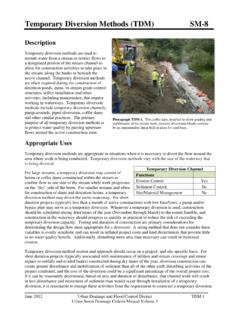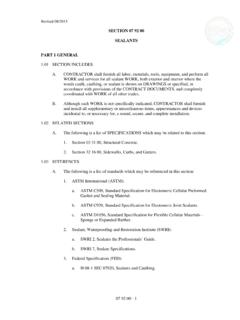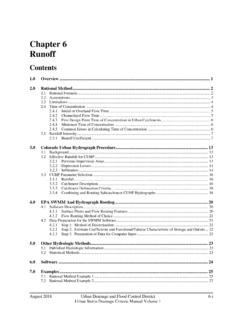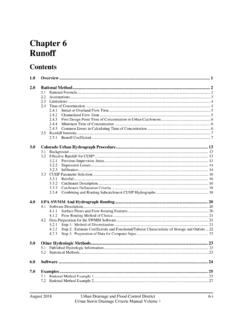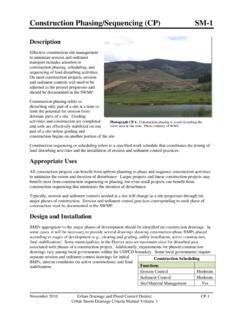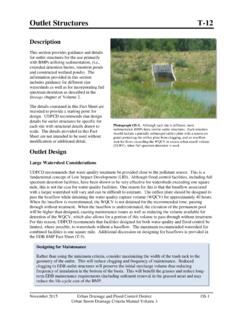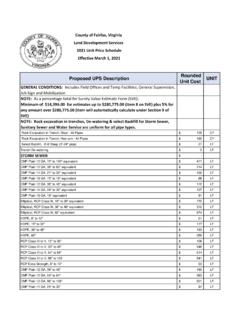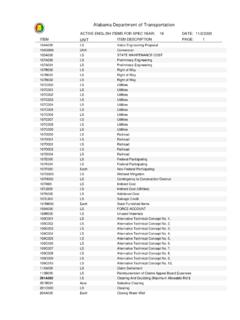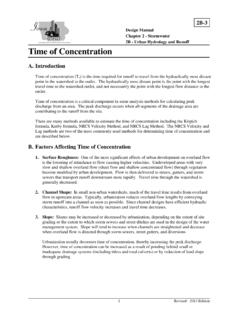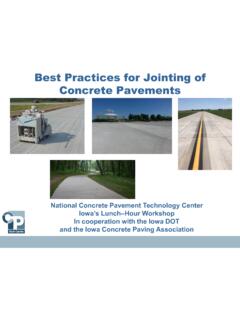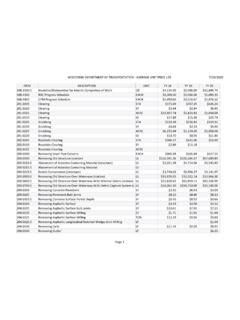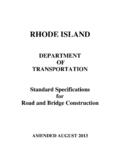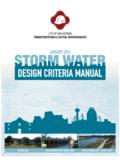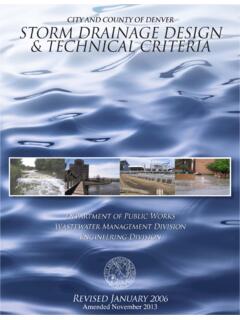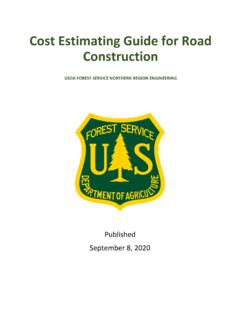Transcription of Chapter 7 Street, Inlets, and Storm Drains
1 January 2016 Urban Drainage and Flood Control District 7- i Urban Storm Drainage Criteria Manual Volume 1 Chapter 7 Street, Inlets, and Storm Drains Contents Introduction .. 1 Purpose and Background .. 1 Urban Stormwater Collection and Conveyance Systems .. 1 System Components .. 2 Minor and Major Storms .. 2 Street Drainage .. 3 Street Function and Classification .. 3 Design Considerations .. 4 Hydraulic Evaluation .. 6 Curb and Gutter .. 6 Swale Capacity .. 12 Inlets .. 13 Inlet Function and Selection .. 13 Design Considerations.
2 13 Grate Inlets on a Continuous Grade .. 15 Curb-Opening Inlets on a Continuous Grade .. 17 Combination Inlets on a Continuous Grade .. 18 Slotted Inlets on a Continuous Grade .. 18 Grate Inlets in a Sump (UDFCD-CSU Model) .. 19 Curb-Opening Inlets in a Sump (UDFCD-CSU Model) .. 20 Other Inlets in a Sump (Not Modeled in the UDFCD-CSU Study) .. 24 Inlet Clogging .. 28 Nuisance Flows .. 29 Inlet Location and Spacing on Continuous Grades .. 32 Design Considerations .. 33 Design Procedure .. 33 Storm Drain Systems .. 34 Introduction.
3 34 Design Process, Considerations, and Constraints .. 34 Storm Drain Hydrology Peak Runoff Calculation .. 36 Storm Drain Hydraulics (Gravity Flow in Circular Conduits) .. 36 Flow Equations and Storm Drain Sizing .. 36 Energy Grade Line and Head Losses .. 38 UD-Inlet Design Workbook .. 48 Examples .. 48 Example Triangular Gutter Capacity .. 48 Example Composite Gutter Capacity .. 49 Example Composite Gutter Capacity Major Storm Event .. 50 Example V-Shaped Swale Capacity .. 52 Example V-Shaped Swale Design .. 53 Example Grate Inlet Capacity.
4 54 Example Curb-Opening Inlet Capacity .. 56 7- ii Urban Drainage and Flood Control District January 2016 Urban Storm Drainage Criteria Manual Volume 1 Example Design of a Network of Inlets Using UD-Inlet .. 57 References .. 61 Tables Table 7-1. Street classification for drainage 3 Table 7-2. Pavement encroachment and inundation standards for the minor Storm .. 4 Table 7-3. Street inundation standards for the major ( , 100-year) Storm .. 5 Table 7-4. Allowable street cross-flow .. 5 Table 7-5. Inlet selection considerations.
5 13 Table 7-6. Splash-over velocity constants for various types of inlet grates .. 16 Table 7-7. Coefficients for various inlets in sumps .. 20 Table 7-8. Sump inlet discharge variables and coefficients .. 26 Table 7-9. Clogging coefficient k for single and multiple units1 .. 28 Table 7-10. Nuisance flows: sources, problems and avoidance strategies .. 31 Table 7-11. Bend loss and lateral loss coefficients (FHWA 2009) .. 44 Table 7-12. Head loss expansion coefficients in non-pressure flow (FHWA 2009) .. 45 Figures Figure 7-1. Gutter section with uniform cross slope.
6 7 Figure 7-2. Typical gutter section composite cross slope .. 8 Figure 7-3. Calculation of composite street section capacity: major Storm .. 10 Figure 7-4. Reduction factor for gutter flow (Guo 2000b) .. 11 Figure 7-5. Typical v-shaped swale section .. 12 Figure 7-6. CDOT type r and Denver no. 14 interception capacity in sag .. 21 Figure 7-7. CDOT type 13 interception capacity in a 23 Figure 7-8. Denver no. 16 interception capacity in sump .. 24 Figure 7-9. Perspective views of grate and curb-opening inlets .. 27 Figure 7-10. Orifice calculation depths for curb-opening inlets.
7 27 Figure 7-11. A pipe-manhole unit .. 40 Figure 7-12. Hydraulic and energy grade lines .. 40 Figure 7-13. Bend loss coefficients .. 46 Figure 7-14. Manhole benching methods .. 47 Figure 7-15. Angle of cone for pipe diameter changes .. 47 Chapter 7 Streets, Inlets, & Storm Drains January 2016 Urban Drainage and Flood Control District 7- 1 Urban Storm Drainage Criteria Manual Volume 1 Photograph 7-1. From 2006 to 2011, hundreds of street and area inlet physical model tests were conducted at the CSU Hydraulics Laboratory, facilitating refinement of the HEC-22 methodology for inlets common to Colorado.
8 Introduction Purpose and Background The purpose of this Chapter is to provide design guidance for stormwater collection and conveyance utilizing streets and Storm Drains . Procedures and equations are presented for the hydraulic design of street drainage, locating inlets and determining capture capacity, and sizing Storm Drains . This Chapter also includes discussion on placing inlets to minimize the potential for icing. Examples are provided to illustrate the hydraulic design process and Excel workbook solutions accompany the hand calculations for most example problems.
9 The design procedures presented in this Chapter are based upon fundamental hydrologic and hydraulic design concepts. It is assumed that the reader has an understanding of basic hydrology and hydraulics. A working knowledge of the Rational Method (Runoff Chapter ) and open channel hydraulics (Open Channels Chapter ) is particularly helpful. The design equations provided are well accepted and widely used. They are presented without derivations or detailed explanation but are properly referenced if the reader wishes to study their background. Inlet capacity, as presented in this Chapter , is based on the FHWA Hydraulic Circular No.
10 22 (HEC-22) methodology (FHWA 2009), which was subsequently refined through a multi-jurisdictional partnership led by Urban Drainage and Flood Control (UDFCD), where hundreds of physical model tests of inlets commonly used in Colorado were performed at the Colorado State University (CSU) Hydraulics Laboratory. The physical model study is further detailed in technical papers available at Additionally, UDFCD developed an inlet design tool, UD-Inlet, which incorporates the findings of the physical model. UD-Inlet is also available at Urban Stormwater Collection and Conveyance Systems Urban stormwater collection and conveyance systems are critical components of the urban infrastructure.
